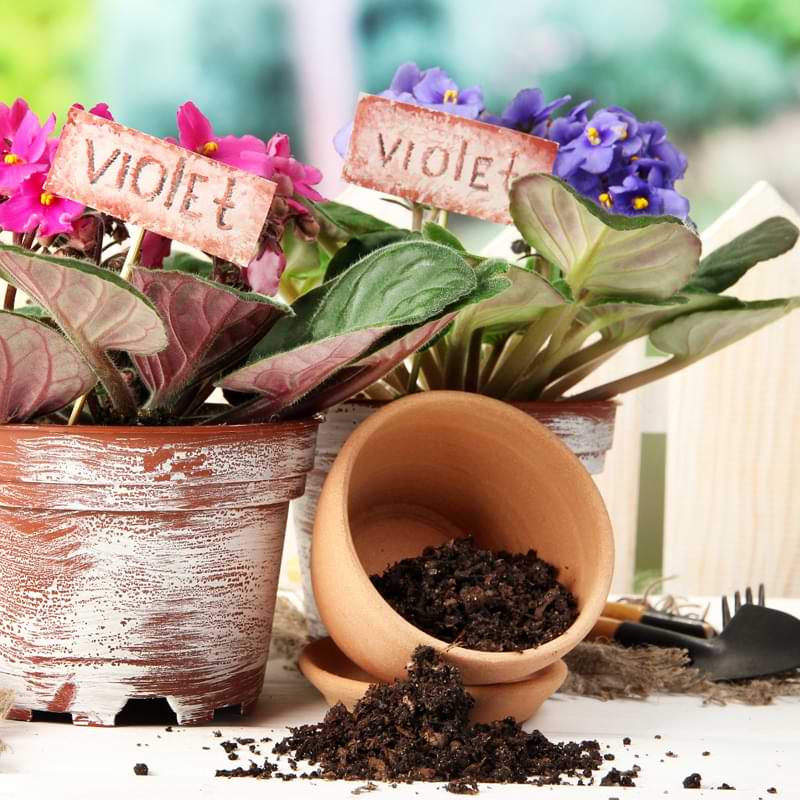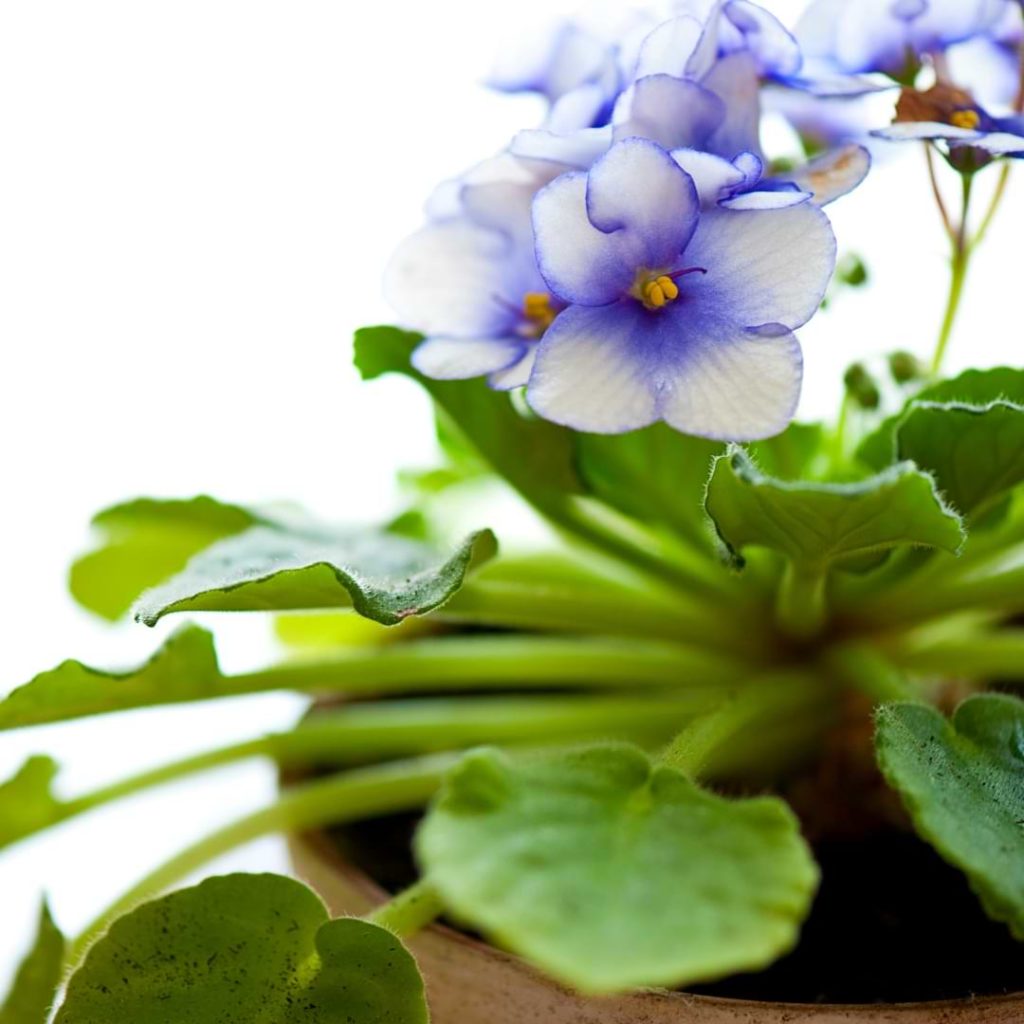African violets have a reputation for being a little finicky. But contrary to popular belief, they’re actually quite hardy! If you’re new to African violets, you just need to understand a few golden rules: keep their leaves dry; avoid direct sunlight; and be mindful of their delicate roots.
The first two rules are pretty straightforward, but how do we take care of an African violet’s sensitive roots? A proper growing medium is key!
The soil in which your plant grows contains its entire universe: nutrients, moisture, and space for its roots to anchor and grow. But plants evolved in all types of different terrain, and potting mix is not one size fits all.
Providing the right African violet potting soil sets you up for success from day one. It’s not complicated, but there are a few things you need to know to keep this unique houseplant happy beneath ground.
Do African Violets Need Special Soil?
Conventional potting mix is too dense for the sensitive African violet. These jungle plants evolved in mossy outcrops with very little soil. A lightweight, soilless planting medium provides support without crushing or choking their delicate root systems.
The perfect African violet potting soil will exhibit the following qualities:
- Retains moisture without waterlogging the container
- Allows for adequate airflow (because roots breathe too!)
- Retains fertilizer and inhibits nutrient leaching
- Boosts humidity above ground
It might sound complex, but you can provide these conditions with just a few key ingredients. Many retailers carry speciality African violet potting soil, and it’s easy to make your own at home. Either way, you’ll want to know the most essential components.
African Violet Soil Recipe: 3 Essential Ingredients
While you’ll find dozens of African violet soil recipes online, nearly all contain three key ingredients: perlite; vermiculite; and peat moss. Each has a specific job to perform, and together they create the perfect conditions that your plant needs to thrive.
1. Perlite
Perlite is a hyper-lightweight material derived from volcanically heated glass. Heating glass in this manner creates a popcorn-like material that retains moisture without impeding drainage. This keeps your plant hydrated without waterlogging it underground. As the porous perlite slowly releases moisture, it boosts humidity in the environment, mimicking the steamy, jungle-like conditions beloved by your plant.
2. Vermiculite
Vermiculite is a flaky mineral often sold in pellet form. It is nontoxic and doesn’t rot or mold, preventing irritating pests from finding safe harbor in your plant’s container. Vermiculite also helps keep potting mix sterile, which keeps your African violet’s blooms fresher longer. Lastly, vermiculite helps soil retain nutrients like ammonium, potassium, and calcium, and accelerates root growth and anchorage.
3. Peat Moss
Peat moss is harvested from decaying plant matter in mossy peat bogs. It helps boost acidity in the soil and maintains soil structure over time. Like perlite and vermiculite, it can hold several times its weight in moisture, slowly releasing it to the plant. By absorbing water, peat moss helps slow the process of leaching and retains more essential nutrients for your plant.
The Problem With Peat Moss
Peat moss is one of the most common ingredients in potting soil of all types. Unfortunately, it’s not the greatest for the planet. Peat is slow-growing, and harvesting peat moss depletes centuries-old bogs much faster than they can be replenished. Peat bogs also act as natural carbon sinks, and when they’re disrupted or diminished, harmful greenhouse gases are released into the atmosphere.
Consider these eco-friendlier alternatives to peat moss:
- Coconut coir: Widely considered the best peat moss alternative, coco coir is made from dried-out fibers harvested from coconut husks. This material is significantly more sustainable, and retains water just as well as peat moss, if not better.
- Wood fiber: Bark chips and wood shavings provide the same air and water flow benefits as peat moss, with less detriment to the environment. However, you’ll want to use a nitrogen-high fertilizer to make up for the nitrogen sequestered by this medium.
African Violet Soil PH
Another factor that sets African violet soil apart is the level of acidity you’ll need to provide. Conventional potting soil is usually quite close to neutral (7.0) acidity, or pH. African violets prefer slightly acidic conditions, between 5.8 to 6.5 pH. In conventional soil, your plant won’t be able to efficiently absorb nutrients.
Generally, peat moss is used to lower the pH in African violet potting soil. Coco coir has also shown to provide sufficient pH when used with traditional fertilizer. If you’re using wood fiber, however, you may want to fertilize with nitrogen-high fertilizer (15-30-15) or add a light organic compost to soil to balance it out.


Mix at Home: DIY African Violet Soil
Most garden centers sell specialty African violet potting mix, but some gardeners prefer to mix their own. Whether you’re looking to avoid commercial chemicals, reduce packaging waste, or simply enjoy making things by hand, DIY African violet soil is easy to make at home.
There’s no perfect formula, but we’re fans of the following recipe:
DIY African Violet Potting Soil Recipe
- 50% peat moss or coco coir (2 cups)
- 25% perlite (1 cup)
- 25% vermiculite (1 cup)
Additional ingredients
- Limestone: To help balance acidity (only add if using peat moss) and prevent toxicities in the soil. Add 1 tablespoon to the recipe above.
- Superphosphate: Encourages strong root growth, great for newly propagated African violets. Add 1 teaspoon to the recipe above.
How to Make DIY African Violet Potting Soil
Making DIY African violet potting soil isn’t as simple as mixing the ingredients above in a pot. First, you’ll need to pasteurize them to eliminate any bacteria, plant diseases, insects, or weed seeds hiding in your ingredients. While home pasteurization might sound intimidating, it’s quite easy to do!
Here’s how to pasteurize your potting mix:
- Heat your oven to 180º Fahrenheit (82º Celcius). This temperature will eliminate any unwanted hitchhikers without frying your ingredients.
- Moisten your soil mixture and spread evenly over a large roasting tray or lipped cookie sheet. If using peat moss, thoroughly wet it before combining it with other ingredients.
- Cover the baking tray with aluminum foil and place in the oven for 45 minutes to an hour.
- Monitor the temperature with a cooking thermometer; don’t let it heat above 180º Fahrenheit or the healthy bacteria in your mix will be eliminated as well.
- Remove the foil and set your mix in the open air for at least four days, stirring several times daily to aerate the soil.
- Once your soil has aired out for the appropriate time, proceed to use what you need to fill your African violet pots and store the rest in a cool, dry place.
Where to Buy African Violet Potting Mix
Even if you’re not interested in making your own mix, you can still enjoy your African violet’s year-round blooms! African violets are one of the most popular houseplants in the world, so many retailers—like Walmart and Menards—sell mix made specially to provide their preferred conditions. Popular brands like Miracle-Gro and Espoma also offer African violet potting soil, available online and at popular retailers.
If you’re looking to support small businesses (we love it!) call up your local nursery and inquire about their specialty mixes, or ask if they mix to order with the materials they have on hand.
Next Steps: Repotting & Transplanting
There’s no shortage of ways to master the mix you need to grow a vibrant, thriving African violet. But that’s not the final step. You may need to repot and transplant your plants too!
Repotting
Once you’ve mastered African violet potting mix, you may want to repot your current plants to introduce fresh, nutrient-rich soil. It’s an easy process, but you’ll want to keep a few things in mind. Always try to repot your plant while it’s healthy and when the soil has had time to dry up a bit. And stay mindful of the delicate root system. Our guide to African violet repotting will walk you through the process step by step.
Transplanting
In the right potting mix, African violets will grow quickly and vigorously. In fact, you may even want to divide up a large individual to propagate more! African violets often grow sucker offshoots with their own root systems, which are easy to separate from the mother plants and rehome. You may also propagate from individual leaves by placing them in a cup of water until new roots sprout.
Learn more: Our Ultimate Guide to Propagating African Violets will teach you everything you need to know!
What else would you like to know about African violet potting soil? Start a conversation in the comments below!
Join the African Violet Club!
Whether you’re just starting out or are a seasoned grower, African Violet Resource Center has everything you need to help your plant grow vibrant and strong. Explore our other articles, visit our online shop, and connect with other houseplant lovers in our Facebook group to learn everything you need to know about this rewarding hobby!
More Great African Violet Resources
How to Remedy Crowded African Violet Leaves
Where to Buy African Violet Plants & Products





